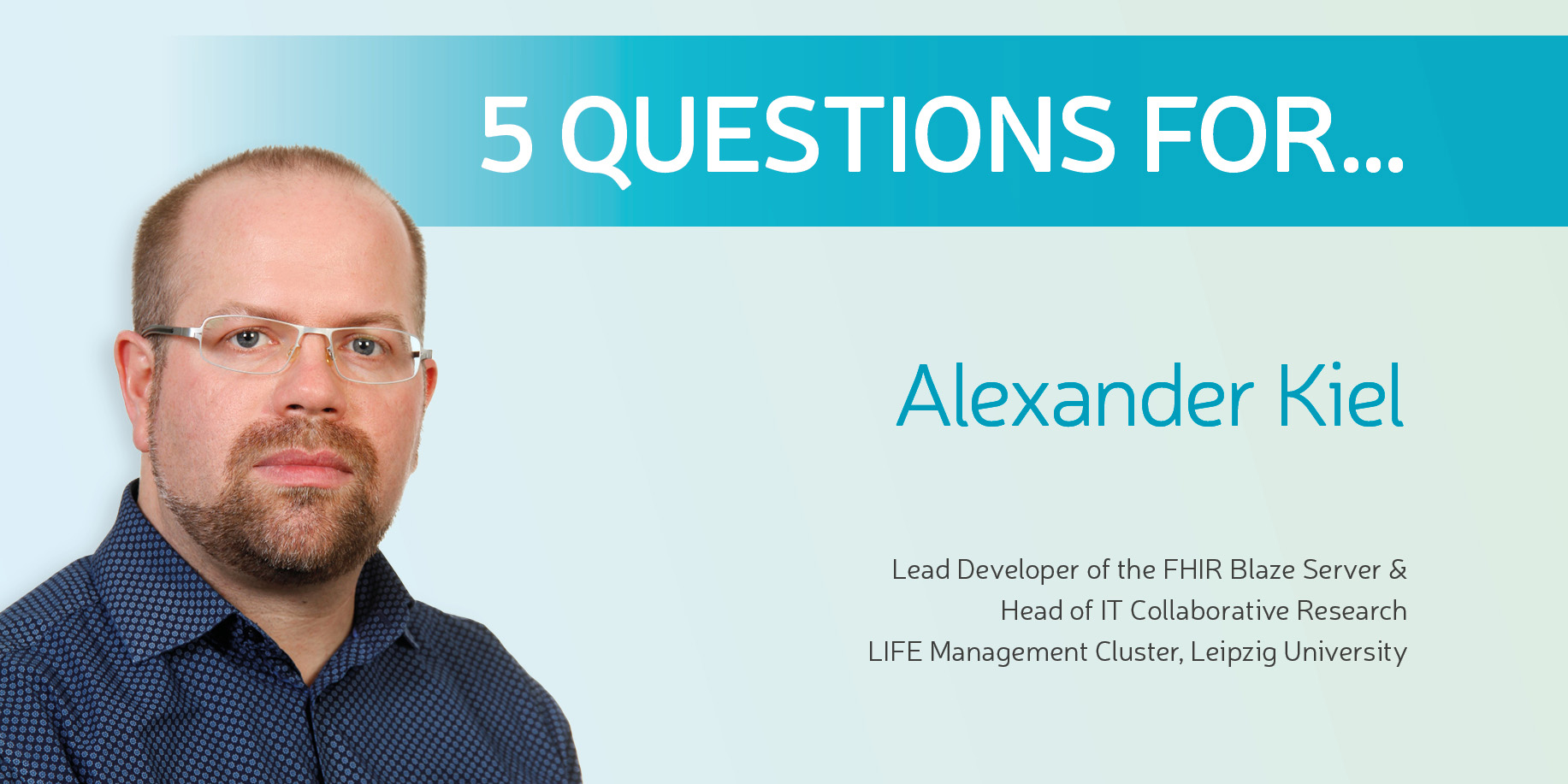
Blaze: A Link Between Research and Patient Care | 5 Questions for… Alexander Kiel on the FHIR Blaze Server
With the Data Integration Centers established nationwide as part of the Medical Informatics Initiative (MII) in Germany, new opportunities have emerged to use routine clinical care data for research purposes. This enables cross-site research projects with large sample sizes and cohort studies. Behind this is a system that can communicate both with routine clinical data from hospitals and with researchers: the Blaze Server. It is based on FHIR*, a widely-used standard for the electronic exchange of health information. Blaze was initially developed in 2019 for the German Biobank Alliance to facilitate the use of biobank samples and was extended to the MII in 2023 as part of the FDPG-Plus project. In this interview, Alexander Kiel, the lead developer of Blaze, shares what makes this server unique and crucial for the work of the MII.
Please explain how the Blaze Server works in simple terms.
The Blaze Server is a specialized database server designed for managing and analyzing medical data. It implements the HL7 FHIR specification, an internationally recognized and widely adopted standard for exchanging and storing medical data. Blaze “speaks” the HL7 FHIR language, allowing it to store and query data structured according to this standard. In addition to FHIR Search, Blaze also supports queries using Clinical Quality Language (CQL). CQL is a domain-specific language standardized by HL7 that is designed to express clinical decision logic and quality measurements in a human-readable, computer-supported manner.
One distinguishing feature of the Blaze Server is its specific focus on medical applications. It’s worth noting that Blaze does not have a user interface but operates as a background program. The server is available on GitHub and can be freely used by healthcare organizations, researchers, and developers.
What was the main motivation behind developing Blaze?
The original use case came from the German Biobank Alliance. The goal of this project, which began in 2018, was to network biobanks across Germany. Similar to the Medical Informatics Initiative, it aimed to enable cross-site requests for data and biosamples. Starting in 2019, our team decided to adopt the FHIR standard for this purpose. However, it soon became clear that the basic FHIR Search capability would not suffice. While FHIR Search allows querying FHIR servers for data, it is very limited because the queries are highly patient-focused. Researchers can look for data in a single patient record, but cohort queries are not feasible. The focus of the MII and the biobanks is precisely to identify as many patients as possible who meet specific criteria for research purposes. Blaze is one of the few FHIR servers that makes this possible. Within the MII, Blaze is used for feasibility queries with the German Portal for Medical Research Data (FDPG) and for data selection and extraction.
What are the challenges in developing and implementing such a system?
The challenges can be divided into four problem areas: The correct implementation of the FHIR standard, regulatory requirements such as the General Data Protection Regulation (GDPR), the fastest possible execution of requests, and the smooth operation of the various locations of the Data Integration Centers in the MII.
First, the FHIR standard: On the one hand, this naturally helps with the implementation because it describes what a server must be able to do and the sites can use this as a guide. On the other hand, these specifications can be interpreted in different ways. This makes communication with standards bodies essential. In terms of regulatory requirements, such as GDPR, one challenge is to cleanly delete the personal data stored at the sites. This would be the case, for example, if a patient withdraws his or her consent.
The volume of data and complex requests also require fast processing, preferably in less than a minute. This requires both performance and functional testing. A tuning guide developed by us helps to optimize Blaze for the existing hardware for the best performance.
How will Blaze evolve in the context of the Medical Informatics Initiative and beyond?
The Blaze Server is currently used by nearly all Data Integration Centers in the MII. This brings specific requests and requirements from the individual Data Integration Centers, which we strive to implement. Blaze is a general-purpose server that adheres to the HL7 standard and is therefore also used in other use cases. In the future, Blaze will be employed in the DISTANCE project, which focuses on Data Integration Centers outside university medicine. This will introduce new requirements, such as the implementation of additional FHIR standard components.
As Blaze becomes more well-known, new demands will arise from various stakeholders. The FHIR standard is gradually gaining traction in Germany. With the MII, we are pioneers in introducing FHIR into hospitals. It is conceivable that FHIR servers will be used much closer to healthcare in the future. Currently, Blaze is more research-focused. However, with the discontinuation of SAP in German hospital information systems (HIS), there is significant change happening. A FHIR server is not an HIS but can serve as a database for one. In summary, FHIR will become increasingly important in the coming years.
Complete the following sentence: Our work within the SMITH Consortium is central to improving research because…
…we provide researchers with access to cross-site medical data.
*About HL7 FHIR
HL7 FHIR (Fast Healthcare Interoperability Resources) is an international standard for exchanging health data, developed by the HL7 (Health Level Seven) organization. This standard makes it easier to exchange medical information such as lab results, diagnoses, and medications between different IT systems in healthcare facilities. FHIR organizes each type of health information into small, reusable data blocks called “resources.” These can be flexibly combined and exchanged without requiring complex adjustments, making data exchange faster and easier, ultimately benefiting patient care.

